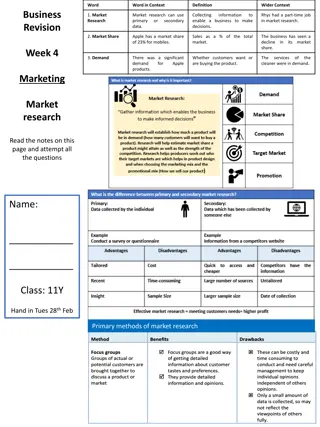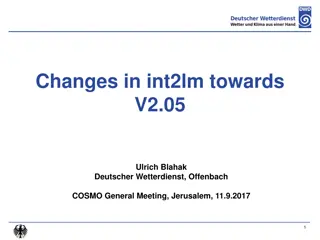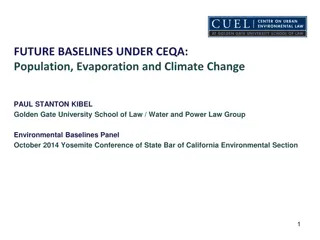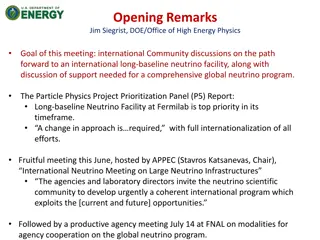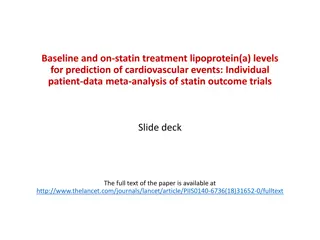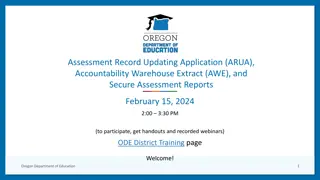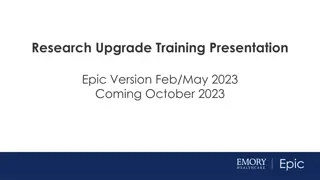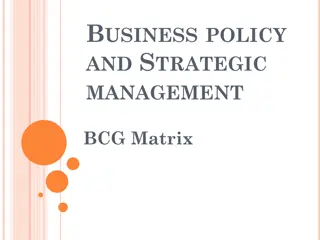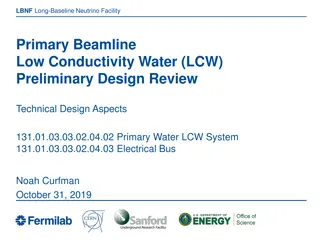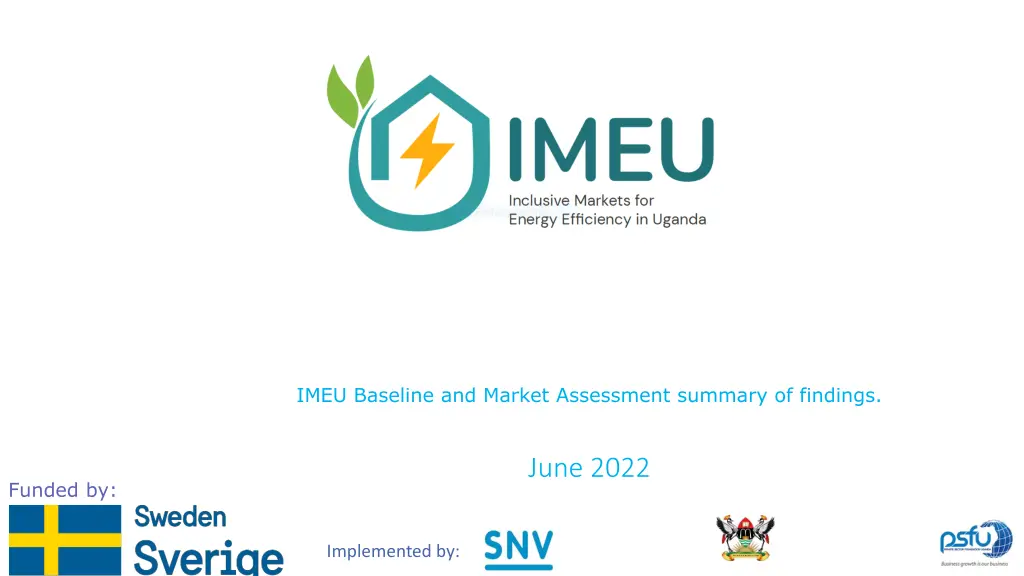
Market Assessment and Value Chain Analysis in Uganda
Explore the findings of a baseline and market assessment focusing on agriculture and the built environment sectors for energy-efficient investments in Uganda. The study includes benchmarking indicators, value chain mapping, demand and supply assessments, policy analysis, financial mapping, and recommendations for project implementation and sustainability.
Download Presentation

Please find below an Image/Link to download the presentation.
The content on the website is provided AS IS for your information and personal use only. It may not be sold, licensed, or shared on other websites without obtaining consent from the author. If you encounter any issues during the download, it is possible that the publisher has removed the file from their server.
You are allowed to download the files provided on this website for personal or commercial use, subject to the condition that they are used lawfully. All files are the property of their respective owners.
The content on the website is provided AS IS for your information and personal use only. It may not be sold, licensed, or shared on other websites without obtaining consent from the author.
E N D
Presentation Transcript
IMEU Baseline and Market Assessment summary of findings. June 2022 Funded by: Implemented by:
The objectives of the Baseline and Market Assessment: 1. Benchmark key project indicators 2. Undertake a value chain mapping for agriculture and built environment sector based on potentials and opportunities for EE investments 3. Undertake a demand and supply assessment for existing and potential EE products and services in Uganda Introduction Introduction 4. Undertake a policy, legal and institutional landscape analysis of the EE sub-sector in Uganda 5. Undertake EE financial landscape mapping analysis for existing and potential financing mechanisms and institutions. 6. Document and share recommendations from the study, that shall support the project implementation, monitoring, and sustainability.
Here we present finding for Objective 2 and 3 of the Baseline and Market Assessment
Introduction Introduction Focus of the Project and the Baseline and Market Assessment
Study Area: The 10 agro- ecological zones Methodology Methodology
Prioritized Agricultural Value chain Dairy Oil milling (sunflower, soya) Maize, tobacco No Agroecological Zone City/District 1 2 North Eastern Dry Lands North Eastern Savanah Grasslands North Western Savannah Grasslands Para Savannah Kioga Plains Lake Victoria Crescent Moroto Lira Study Area: Agricultural Value chains 3 Gulu, Arua Methodology Methodology 4 5 6 Masindi Mbale Kampala, Masaka Kabarole, Hoima Kiruhura Mbarara Kabale Sugar cane Maize, Coffee Horticulture, Coffee Tea, Sugarcane Western Savannah Grasslands Pastoral Rangelands South Western Farmlands Highland Ranges 7 8 9 10 Diary Dairy Horticulture
Data collection and management Mixed data collection methods- Qualitative and Quantitative Data collected, Primary and secondary data collected Surveys-Sample based data collection Households (1057) Social Institutions (152) Commercial Buildings (158) Businesses (101) Agribusinesses (145) Interviews Academia (13) Government MDAs (25) Development Partners, Technology suppliers(25) Focused Group Discussions Men and women FGDs (37) Methodology
Methodology Methodology Distribution of target groups in rural and peri-urban/urban areas
Limitations faced Limitations faced Failure to access some institutions (e.g. prison barracks, hospitals) on grounds of lack of clearance from line ministries by the data collectors.- These were excluded from the study Mistrust where respondents think that data collectors are from URA, or UNBS or NEMA or business competitors.-Necessitated taking more time to explain to explain the purpose of the assessment Refusals by respondents to provide info such as investments, incomes
Objective 2: Undertake Value chain mapping for agriculture and built environment sector based on potentials and opportunities for EE investments Findings
Energy sources in built environment The energy sources are preferred because they are affordable and accessible. No seasonal variations were reported Sources are mainly purchased Costs have increased over time
Main cooking technologies in the built environment Main cooking technologies in the built environment Commercial buildings Type of technology Households Social institutions EE cooking technologies used in 42.9% of the households, 55% of the social institutions, and 68.8% of the commercial buildings Inefficient technologies still used (cheaper and more accessible) Response 350 212 37 13 145 290 1 1 0 4 4 1057 Percent Response Percent Response Percent 33.1% 49 38.0% 20.1% 2 1.6% 3.5% 1 0.8% 1.2% 3 2.3% 13.7% 61 47.3% 27.4% 5 3.9% 0.1% 0 0.0% 0.1% 0 0.0% 0.0% 0 0.0% 0.4% 2 1.6% 0.4% 6 4.7% 100.0% 129 100.0% Three stone open fire Ceramic charcoal stove Metallic charcoal stove LPG stove EE wood stove EE charcoal stove Briquette stove Kerosene stove Biogas stove Electric stove Other Total 2 23 0 17 9 27 0 1 1 12 4 96 2.1% 24.0% 0.0% 17.7% 9.4% 28.1% 0.0% 1.0% 1.0% 12.5% 4.2% 100.0%
Main heating technologies in the built environment Main heating technologies in the built environment Type of technology Households Commercial buildings Social institutions EE heating technologies used in 31.1% of the households, 82.4% of the social institutions, and 90.9% of the commercial buildings Inefficient technologies still used in households Response Percent Response Percent Response Percent Three stone open fire Ceramic charcoal stove LPG stove Improved wood stove Improved charcoal stove 28 3 1 8 4 62.2% 6.7% 2.2% 17.8% 8.9% 2 0 0 3 0 11.8% 0.0% 0.0% 17.6% 0.0% 0 0 0 0 0 0.0% 0.0% 0.0% 0.0% 0.0% Kerosene stove Electric stove Electric water heater Solar water heater Electric autoclave sterilizer Electric warmers Traditional sauna heaters Total 0 0 1 0 0 0.0% 0.0% 2.2% 0.0% 0.0% 1 1 3 0 6 5.9% 5.9% 17.6% 0.0% 35.3% 0 0 0.0% 0.0% 81.8% 9.1% 0.0% 18 2 0 0 0 0.0% 0.0% 100.0% 1 0 17 5.9% 0.0% 100.0% 0 2 0.0% 9.1% 100.0% 45 22
Main lighting energy sources in the built environment Main lighting energy sources in the built environment Source Households Social Institutions Commercial buildings Response Percent Response Percent Response Percent Clean energy sources are mainly used in the built environment Use of kerosene and candles Kerosene Electricity Diesel/petrol 49 537 1 5% 51% 0% 1 1% 87% 0% 0 0% 94% 0% 132 0 148 0 Candles Firewood Solar Battery Dry cells None Total 40 1 365 15 50 2 1060 4% 0% 34% 1% 5% 0% 100% 0 0 0% 0% 9% 0% 1% 3% 100% 0 0 6 0 0 3 0% 0% 4% 0% 0% 2% 100% 14 0 1 4 152 158
Main lighting technologies in the built environment Main lighting technologies in the built environment Technology Households Response 16 Institutions Response 1 Commercial buildings Response 0 Percent 1.5% Percent 0.7% Percent 0.0% EE lighting technologies used in 86.6% of households, 84.9% of social institutions, and 84.2% of commercial buildings Kerosene lantern Light Emitting Diode bulbs Other electricity bulbs Generator Candles Solar lights Tadooba Battery lamp/torch Biogas lamps None Total 514 48.5% 112 73.7% 127 80.4% 39 1 43 335 39 3.7% 0.1% 4.1% 31.6% 3.7% 17 0 0 15 0 11.2% 0.0% 0.0% 9.9% 0.0% 18 3 0 6 0 11.4% 1.9% 0.0% 3.8% 0.0% 68 1 4 6.4% 0.1% 0.4% 100.0% 2 0 5 1.3% 0.0% 3.3% 100.0% 0 0 4 0.0% 0.0% 2.5% 100.0% 1060 152 158
Main energy sources in agribusinesses Main energy sources in agribusinesses Main Energy Source used by the Agribusinesses 80.0% Choice of energy sources is influenced by accessibility and type of machines used 68.1% 70.0% 60.0% Only 33% of the agribusinesses use EE Technologies 50.0% 40.0% 30.0% 20.8% 20.0% 9.7% 10.0% 0.7% 0.7% 0.0% Hydro Wood Diesel Charcoal Others
Barriers to adoption of Energy Efficiency Technology Barriers to adoption of Energy Efficiency Technology among agribusinesses among agribusinesses Reasons for not using EE technologies Percentage High cost of acquisition 25% Lack of accessibility 4% Lack of awareness 48% Limited Capital 16% Others 7% Total 100%
Objective 3: Undertake a demand and supply assessment for existing and potential EE products and services in Uganda Findings
Most households (78%), social institutions (84%), and commercial buildings (72%) were aware of energy-efficient cooking and heating technologies Awareness of EE Most of the respondents (87% of the households, 90.1% of the social institutions, and 89.8% of commercial buildings) were aware of energy-efficient lighting technologies technologies and their Benefits More than 80% of the households, social institutions and commercial buildings knew that EE cooking/heating technologies save fuel, cook/heat quickly and are durable. Most respondents knew that EE lighting technologies save electricity (72% of households, 85% of social institutions, and 82% of the commercial buildings).
Awareness of EE technologies Word of mouth and Radio/TV are the most popular sources of info on EE technologies. Main sources of information EE technologies Source of information Households Social institutions Frequency 40 3 46 Commercial buildings Frequency 50 8 29 Frequency 190 72 379 Percent 23.3% 8.8% 46.6% Percent 31.5% 2.4% 36.2% Percent 44.2% 7.1% 25.7% Radio/TV advertisement Market day promotion Word of mouth/neighbor/friend Newspaper or other print advertisements NGO campaign Retailer promotion/information Others Total 5 0.6% 5 3.9% 1 0.9% 16 142 2.0% 17.4% 14 13 11.0% 10.2% 0 0.0% 20.4% 23 10 814 1.2% 100.0% 6 4.7% 100.0% 2 1.8% 100.0% 127 113
Energy-efficient cooking and heating technologies are accessible for about half of the households (51.8%), social institutions (56.5%), and commercial buildings (52.5%) Accessibility to EE products/services Energy-efficient lighting technologies are accessible for most households (75.0%), social institutions (77.6%), and commercial buildings (84.8%)
Willingness to adopt EE Technologies among Households, Social Institutions, Commercial Buildings and Agribusinesses 85% 90% 82% 78% 80% 74% 73% 68.10% 70% 64% 60% 50% 40% 30% 20% 10% 0% Households Social Institutions Commercial buildings Agribusinesses Willingness to buy EE cooking/heating technologies Willingness to buy EE lighting technologies Willingness to buy EE technologies
Willingness to buy EE cooking/heating technologies Motivation for the willingness: technologies save fuel, are durable and cook/heat quickly. Reasons for the unwillingness: technologies are expensive and difficult to find in their locations More investment is required to influence attitude and willingness to adopt among Commercial buildings
Financing options for acquisition EE technologies Instalment payments is the most preferred financing option
Supply of EE products More businesses were involved in selling EE lighting and cooking technologies Mainly Wood, charcoal, briquette cookstoves, electric cookers, LEDs, and solar technologies are supplied There is very limited investment in EE technologies for Agroprocessing
Willingness to supply Vs ability to supply EE products 9 in 10 businesses (91%) were willing to provide the demanded products BUT close to 5 in 10 (46.8%) cited inadequate capital as a major limitation to supply the demanded products.
Options for EE financing to Supply EE products for Businesses citing inadequate capital Only about 46% of the businesses were aware of financial institutions that offer financing options for EE products
Services offered by ESCOs (ESPCs) The Businesses assessed as ESCOs can best be described as ESPCs by virtue of the service package they offer. Most ESPCs provide Energy and/or Supply equipment
Conclusions The potential for EE technologies exists and can be harnessed through tailor- made awareness creation on the efficacy and benefits of EE technologies, innovative financing options, and the creation of technology distribution networks to reach the potential users. The demand for EE products and services exists. The supply of products and services is available but there is limited accessibility in some areas The policies and institutional frameworks regarding energy efficiency exist. However, gaps still exist in terms of policy focus and awareness There are financial institutions that offer financing for EE products and services. However, more institutions need to come on board









